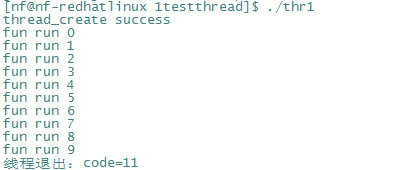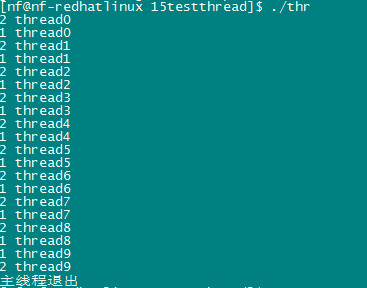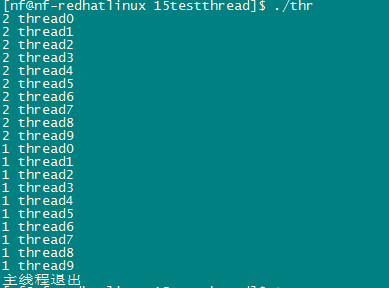我们在写linux的服务的时候,经常会用到linux的多线程技术以提高程序性能
多线程的一些小知识:
一个应用程序可以启动若干个线程。
线程(Lightweight Process,LWP),是程序执行的最小单元。
一般一个最简单的程序最少会有一个线程,就是程序本身,也就是主函数(单线程的进程可以简单的认为只有一个线程的进程)
一个线程阻塞并不会影响到另外一个线程。
多线程的进程可以尽可能的利用系统CPU资源。
1创建线程
先上一段在一个进程中创建一个线程的简单的代码,然后慢慢深入。
#include<pthread.h> #include<stdio.h> #include<stdlib.h> #include<string.h> #include<errno.h> void * func(void * arg) { printf("func run... "); return NULL; } int main() { pthread_t t1; int err = pthread_create(&t1,NULL,func,NULL); if(err!=0) { printf("thread_create Failed:%s ",strerror(errno)); }else{ printf("thread_create success "); } sleep(1); return EXIT_SUCCESS; }
int pthread_create(pthread_t *thread,const pthread_attr_t *attr, void *(*start_routine)(void*), void *arg);
在main函数里面我们调用上面的函数进行创建一个线程。
函数参数:
第一个参数:pthread_t代表创建线程的唯一标识,是一个结构体,需要我们创建好后,将这个结构体的指针传递过去。
第二个参数:pthread_attr_t,代表创建这个线程的一些配置,比如分配栈的大小等等。。一般我们可以填NULL,代表默认的创建线程的配置
第三个参数:代表一个函数的地址,创建线程时,会调用这个函数,函数的返回值是void*,函数的参数也是void*,一般格式就像void * func(void * arg){}
第四个参数:代表调用第三个函数传递的参数
函数返回值:
函数成功返回0,如果不等于0则代表函数调用失败,此时通过strerror(errno)可以打印出具体的错误。
注意:每个线程都拥有一份errno副本,不同的线程拥有不同的errno
最后通过gcc编译
gcc 1createthread.c -c -o 1createthread.o
gcc 1createthread.o -o thr1 -lpthread
编译的时候需要加上-lpthread 用来链接libpthread.so动态库,不然会提示找不到function
函数调用返回结果

问题:为什么调用sleep函数
答:可能新创建的线程还没运行到打印的方法主线程就结束了,而主线程结束,所有线程都会结束了。
2线程挂起
有时候我们在一个线程中创建了另外一个线程,主线程要等到创建的线程返回了,获取该线程的返回值后主线程才退出。这个时候就需要用到线程挂起。
int pthread_join(pthread_t th, void **thr_return);。
pthread_join函数用于挂起当前线程,直至th指定的线程终止为止。
#include<pthread.h> #include<stdio.h> #include<stdlib.h> #include<string.h> #include<errno.h> void * func(void * arg) { int i=0; for(;i<5;i++) { printf("func run%d ",i); sleep(1); } int * p = (int *)malloc(sizeof(int)); *p=11; return p; } int main() { pthread_t t1,t2; int err = pthread_create(&t1,NULL,func,NULL); if(err!=0) { printf("thread_create Failed:%s ",strerror(errno)); }else{ printf("thread_create success "); } void *p=NULL; pthread_join(t1,&p); printf("线程退出:code=%d ",*(int*)p); return EXIT_SUCCESS; }
函数执行结果

我们主函数一直在等待创建的线程执行完,并且得到了线程执行结束的返回值
3线程终止
进程终止时exit()函数,那么线程终止是什么呢?
线程终止的三种情况:
- 线程只是从启动函数中返回,返回值是线程的退出码。
- 线程可以被同一进程中的其他线程取消。
- 线程调用pthread_exit。
#include<pthread.h> #include<stdio.h> #include<stdlib.h> #include<string.h> #include<errno.h> void * func(void * arg) { int i=0; while(1) { if(i==10) { int * p = (int *)malloc(sizeof(int)); *p=11; pthread_exit(p); } printf("fun run %d ",i++); sleep(1); } return NULL; } int main() { pthread_t t1,t2; int err = pthread_create(&t1,NULL,func,NULL); if(err!=0) { printf("thread_create Failed:%s ",strerror(errno)); }else{ printf("thread_create success "); } void *p=NULL; pthread_join(t1,&p); printf("线程退出:code=%d",*(int*)p); return EXIT_SUCCESS; }
void pthread_exit(void *arg);
pthread_exit函数的参数就跟正常线程结束return的使用时一样的,都会被等待它结束的主线程获取到。
函数运行结果:

4线程分离
int pthread_detach(pthread_t th);
pthread_detach函数使线程处于被分离状态。
如果不等待一个线程,同时对线程的返回值不感兴趣,可以设置这个线程为被分离状态,让系统在线程退出的时候自动回收它所占用的资源。
一个线程不能自己调用pthread_detach改变自己为被分离状态,只能由其他线程调用pthread_detach。
5线程取消
int pthread_cancel(pthread_t th);
pthread_cancel函数允许一个线程取消th指定的另一个线程。
函数成功,返回0,否则返回非0。
#include<pthread.h> #include<stdio.h> #include<stdlib.h> #include<string.h> #include<errno.h> void * func1(void * arg) { while(1) { printf("fun run... "); sleep(1); } return NULL; } int main() { pthread_t t1; if(pthread_create(&t1,NULL,func1,NULL)!=0) { printf("thread_create Failed:%s ",strerror(errno)); return -1; } sleep(5); pthread_cancel(t1); pthread_join(t1,NULL); return EXIT_SUCCESS; }
函数执行结果:

上面我们说过创建一个线程函数pthread_create的第二个参数,用来决定创建线程的一些初始化状态,这里我们 举个例子,改线程一创建就是分离状态的线程(
)
先上一段代码:
#include<pthread.h> #include<stdio.h> #include<stdlib.h> #include<string.h> #include<errno.h> void * func(void * arg) { int i=0; for(;i<5;i++) { printf("func run%d ",i); sleep(1); } int * p = (int *)malloc(sizeof(int)); *p=11; return p; } int main() { pthread_t t1; pthread_attr_t attr;//申明一个attr的结构体 pthread_attr_init(&attr);//初始化结构体 pthread_attr_setdetachstate(&attr, PTHREAD_CREATE_DETACHED);//设置线程为分离线程 int err = pthread_create(&t1,&attr,func,NULL); if(err!=0) { printf("thread_create Failed:%s ",strerror(errno)); }else{ printf("thread_create success "); } pthread_attr_destroy(&attr); pthread_join(t1,NULL); printf("主线程退出 "); return EXIT_SUCCESS; }
pthread_attr_t就是我们要传入的参数的结构体,一般申明的步骤有
1,申明一个pthread_attr_t对象
3,设置线程的一些属性,比如pthread_attr_setdetachstate函数就是设置该线程创建的时候为正常状态还是分离状态。
4,函数pthread_attr_destroy释放attr内存空间
pthread_attr_setdetachstate把线程属性设置为下面两个合法值之一:
|
值 |
说明 |
|
PTHREAD_CREATE_DETACHED |
设置线程为分离状态 |
|
PTHREAD_CREATE_JOINABLE |
设置线程为正常状态 |
上面函数运行结果:

因为线程是个分离状态的,所以pthread_join挂起会失效,主线程很快运行结束,程序也就结束了,创建的线程还没来得及运行
线程同步
有时候我们多个线程处理订单扣减库存会遇到这样的问题,两个线程同时进入一段代码先查询库存,两个都查出来为还剩一件库存,第一个线程用掉这个库存后,将库存变为0,但是第二个线程刚才也查出来为1了,所以他还认为有库存,
这个时候操作就会引发我们想不到的意外,库存变为负数了!!所以这个时候就需要使用线程的同步!!
先上一段代码看看效果:
#include<pthread.h> #include<stdio.h> #include<pthread.h> #include<stdio.h> #include<stdlib.h> #include<string.h> #include<errno.h> void * func(void * arg) { int threadno =*(int*)arg; int i=0; for(;i<10;i++) { printf("%d thread%d ",threadno,i); sleep(1); } return NULL; } int main() { pthread_t t1,t2; int i1=1,i2=2; pthread_create(&t1,NULL,func,&i1); pthread_create(&t2,NULL,func,&i2); pthread_join(t1,NULL); pthread_join(t2,NULL); printf("主线程退出 "); return EXIT_SUCCESS; }
函数运行结果:

可以看到两个线程是没有规律的争相处理的,如果这段代码是扣减库存就完蛋啦!,所以我们要对这段代码进行加锁,同一时刻只能有一个线程进入操作!
先上代码:
#include<pthread.h> #include<stdio.h> #include<stdlib.h> #include<string.h> #include<errno.h> pthread_mutex_t mutex = PTHREAD_MUTEX_INITIALIZER; void * func(void * arg) { pthread_mutex_lock(&mutex);//对mutex加锁,其他线程进入后将会挂起,知道这个锁被解锁 int threadno =*(int*)arg; int i=0; for(;i<10;i++) { printf("%d thread%d ",threadno,i); sleep(1); } pthread_mutex_unlock(&mutex); return NULL; } int main() { pthread_t t1,t2; int i1=1,i2=2; pthread_create(&t1,NULL,func,&i1); pthread_create(&t2,NULL,func,&i2); pthread_join(t1,NULL); pthread_join(t2,NULL); printf("主线程退出 "); return EXIT_SUCCESS; }
函数运行结果:

可以看到第二个线程先进入后一直运行结束,对mutex解锁后,第一个线程才能进方法里面运行!否则会挂起,一直等到锁被解锁!
pthread_mutex_t mutex = PTHREAD_MUTEX_INITIALIZER;
加锁解锁函数:
int pthread_mutex_lock(pthread_mutex_t *mutex);
int pthread_mutex_unlock(pthread_mutex_t *mutex);